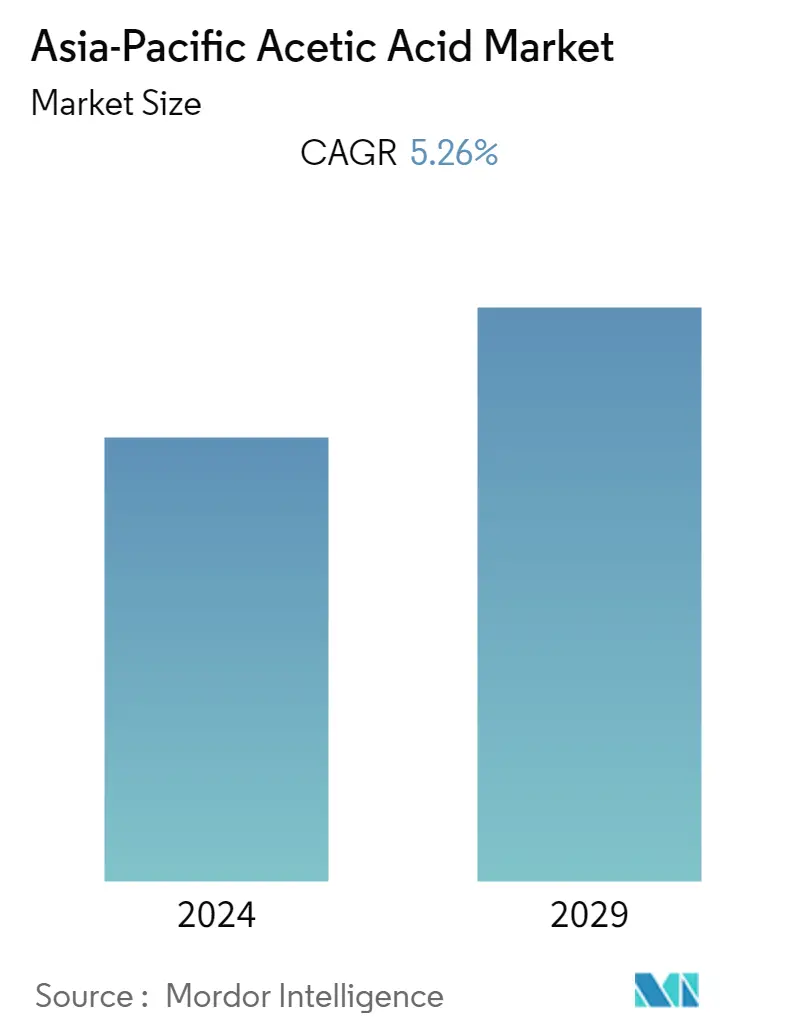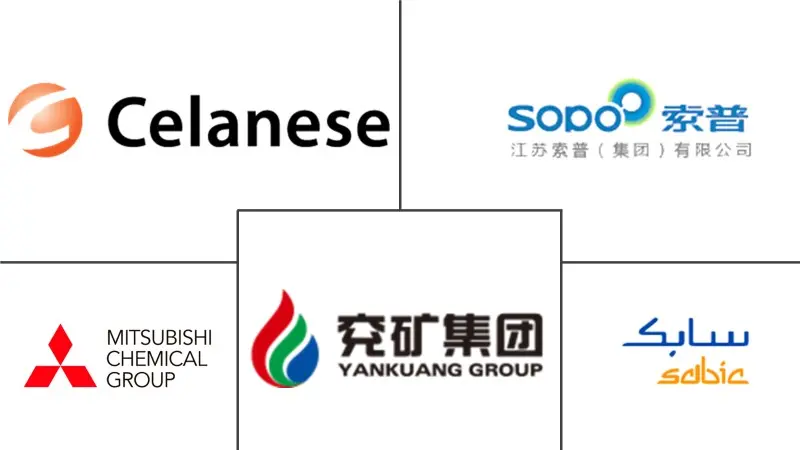
| Study Period | 2019 - 2029 |
| Base Year For Estimation | 2023 |
| Forecast Data Period | 2024 - 2029 |
| CAGR | 5.26 % |
| Fastest Growing Market | Asia Pacific |
| Largest Market | Asia Pacific |
| Market Concentration | Medium |
Major Players
*Disclaimer: Major Players sorted in no particular order |
Asia-Pacific Acetic Acid Market Analysis
The Asia-Pacific Acetic Acid Market is estimated to reach 12.24 million tons by the end of this year and is projected to reach 15.82 million tons in the next five years, registering a CAGR of 5.26% during the forecast period.
The COVID pandemic negatively impacted the Asia-Pacific region's acetic acid market. China, one of the largest manufacturers of acetic acid, had worst hit by the COVID pandemic, which resulted in production halts. However, Post-COVID, the market for acetic acid recovered due to increasing demand from end-user industries like adhesives, paints and coatings, and food and beverage.
- Over the short term, the increasing demand for vinyl acetate monomer (VAM), and the increasing demand from the paints and coatings industries, are some of the driving factors for the growth of the acetic acid market.
- On the contrary, environmental concerns regarding the harmful effects of acetic acid and increasing prices of raw materials have been hindering the growth of the acetic acid market.
- The development of new separation technologies to increase the production efficiency of acetic acid is expected to create opportunities for the market during the forecast period.
- China is expected to dominate the market. It is also expected to register the highest CAGR during the forecast period.
Asia-Pacific Acetic Acid Industry Segmentation
Acetic acid is a monocarboxylic acid containing two carbons. It is a clear, colorless liquid with a strong, pungent odor, like vinegar. Acetic acid can be derived from the carbonylation of methanol, the oxidation of acetaldehyde and ethylene, or a biological method like bacterial fermentation. It is used as a chemical reagent to produce several chemical compounds like acetic anhydride, ester, vinyl acetate monomer, vinegar, and many other polymeric materials.
The Asia-Pacific acetic acid market is segmented by derivative, application, and geography. By derivative, the market is segmented into vinyl acetate monomer (VAM), purified terephthalic acid (PTA), ethyl acetate, acetic anhydride, and other derivatives. By application, the market is segmented into plastics and polymers, food and beverage, adhesives, paints and coatings, textiles, medical, and other applications. By geography, the market is segmented into China, India, Japan, South Korea, Indonesia, Thailand, Malaysia, Philippines, Vietnam, Australia and New Zealand, and the Rest of Asia-Pacific. The report also covers the market size and forecasts for the acetic acid market in 10 countries in the region. Each segment's market sizing and forecasts are based on volume (million tons).
| Vinyl Acetate Monomer (VAM) |
| Purified Terephthalic Acid (PTA) |
| Ethyl Acetate |
| Acetic Anhydride |
| Other Derivatives |
| Plastics and Polymers |
| Food and Beverage |
| Adhesives, Paints, and Coatings |
| Textile |
| Medical |
| Other Applications |
| Asia-Pacific | China |
| India | |
| Japan | |
| South Korea | |
| Indonesia | |
| Thailand | |
| Malaysia | |
| Philippines | |
| Vietnam | |
| Australia and New Zealand | |
| Rest of Asia-Pacific |
Asia-Pacific Acetic Acid Market Size Summary
The Asia-Pacific acetic acid market is experiencing a recovery and growth trajectory following the disruptions caused by the COVID-19 pandemic, particularly in China, a major producer. The market is driven by increasing demand from various end-user industries such as adhesives, paints and coatings, and food and beverages. The rising demand for vinyl acetate monomer and the expansion of the paints and coatings sector are significant contributors to market growth. However, challenges such as environmental concerns and rising raw material costs pose obstacles. Innovations in separation technologies are anticipated to offer new opportunities for enhancing production efficiency. China is expected to maintain its dominance in the market, benefiting from its robust industrial and manufacturing sectors, which heavily rely on acetic acid for applications in electronics, automobiles, textiles, and packaging.
The demand for acetic acid in the Asia-Pacific region is further bolstered by the growth of the construction and automotive industries, particularly in China, India, and South Korea. The increasing production of vehicles and the expansion of the construction sector in these countries are key factors driving the market. In China, the construction industry's output value and the burgeoning plastics and textiles sectors contribute significantly to the demand for acetic acid. The market is characterized by partial consolidation, with major players like Celanese Corporation, Jiangsu SOPO (Group) Co. Ltd, and Mitsubishi Chemical Corporation leading the industry. Recent developments, such as the commissioning of new production facilities and strategic acquisitions, indicate a proactive approach by companies to strengthen their market positions and meet the growing demand for acetic acid in the region.
Asia-Pacific Acetic Acid Market Size - Table of Contents
1. MARKET DYNAMICS
-
1.1 Drivers
- 1.1.1 Increasing Demand for Vinyl Acetate Monomer (VAM)
- 1.1.2 Growing Paints and Coatings Industry
- 1.1.3 Other Drivers
-
1.2 Restraints
- 1.2.1 Environmental Concerns Regarding the Harmful Effects
- 1.2.2 Increasing Prices of Raw Materials
- 1.3 Industry Value-Chain Analysis
-
1.4 Porter's Five Forces Analysis
- 1.4.1 Bargaining Power of Suppliers
- 1.4.2 Bargaining Power of Buyers
- 1.4.3 Threat of New Entrants
- 1.4.4 Threat of Substitute Products and Services
- 1.4.5 Degree of Competition
2. MARKET SEGMENTATION (Market Size in Volume)
-
2.1 Derivative
- 2.1.1 Vinyl Acetate Monomer (VAM)
- 2.1.2 Purified Terephthalic Acid (PTA)
- 2.1.3 Ethyl Acetate
- 2.1.4 Acetic Anhydride
- 2.1.5 Other Derivatives
-
2.2 Application
- 2.2.1 Plastics and Polymers
- 2.2.2 Food and Beverage
- 2.2.3 Adhesives, Paints, and Coatings
- 2.2.4 Textile
- 2.2.5 Medical
- 2.2.6 Other Applications
-
2.3 Geography
- 2.3.1 Asia-Pacific
- 2.3.1.1 China
- 2.3.1.2 India
- 2.3.1.3 Japan
- 2.3.1.4 South Korea
- 2.3.1.5 Indonesia
- 2.3.1.6 Thailand
- 2.3.1.7 Malaysia
- 2.3.1.8 Philippines
- 2.3.1.9 Vietnam
- 2.3.1.10 Australia and New Zealand
- 2.3.1.11 Rest of Asia-Pacific
Frequently Asked Questions
What is the current undefined size?
The undefined is projected to register a CAGR of 5.26% during the forecast period (2025-2030)
Who are the key players in undefined?
Celanese Corporation, Jiangsu SOPO (Group) Co., Ltd., Yankuang Group, SABIC and Mitsubishi Chemical Corporation are the major companies operating in the undefined.


